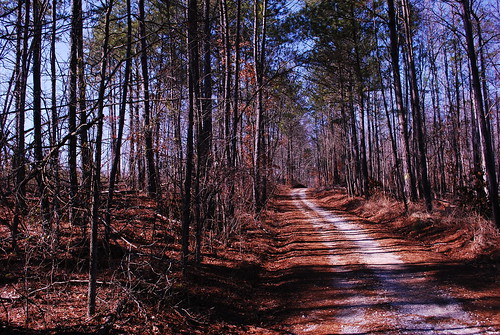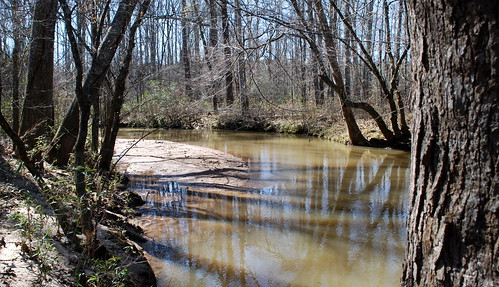
Since I often hike alone, silence seemed completely natural the day I decided to explore the 2,100 acre grounds of Southern Monastery. The snow had melted, and it was warm enough to strip down to a t-shirt as I followed a winding path through the woods. The first part of the trail, which was covered with crushed stone, glinted in the sunlight, just like the roads at the monastery did. Bits of mica, I guess, or some other shiny rock. I couldn't help feeling, the whole time at the monastery, that I was in some magical place. The very roads glittered.
I'd been hiking for about 30 minutes when I heard noises: laughing and talking. A group of college students were doing trail work, and they came past carrying rakes and saws and piles of old branches. They were teasing each other and giggling and squealing in the way that kids their age do. I often accompany my own students on this kind of service project so the chatter was familiar, but it made me smile to hear the accents -- very definitely southern accents -- and the swirl of noise seemed startling after the silence of the monastery. They smiled back at me as they went past, and soon I was on my own again.
I was hiking through a cemetery, actually, even though I saw no tombstones. I'd read about the cemetery online before I'd arrived at the monastery. They practice conservation or "green" burial. The bodies are not embalmed: they are wrapped in a shroud or biodegradable box, and they are buried about three feet down, with a mound of dirt on top. Instead of a tombstone, a tree or bunch of wildflowers or native rock might mark the grave. The expectation is that the bodies will decay and return to the earth, a process that is both ecological and biblical. ("Dust you are, and unto dust you shall return.") People who choose to buy plots are choosing to help preserve a piece of land. And they save their families money, too, since "green" burial is about half the price of a contemporary burial.
The land had been a terraced farm, a hundred years or so ago, and the trails wound their way up and down hills. I found a bridge over a muddy stream where I could sit in the sun and listen to the water pushing silt along the banks. On one hillside, I found clumps of daffodils, scattered near what I'm guessing was the foundation to a farmhouse. Even though I've been to City That Burned During the Civil War several times for conferences, this was my first time seeing some of the landscape outside of the city, and I admired how beautiful it was: the tangled vines that hung from the trees, the stream that swirled around smooth banks of mud, and the spectacular red soil that made the ground itself so pretty.


5 comments:
I love that top photo.
I'd choose that kind of cemetery I think. It makes sense.
i can picture it all. in south carolina, at least on the coastal side, the gravel might have been replaced by discarded shells. the dirt near the coast would not be so red. but, the vines and trees and waterways and weather -- probably not so different.
i've heard about those green cemetaries. think they may have a little more history in england, but no way of knowing for sure.
what a wonderful hike! Thank you for sharing. This kind of cemetery does make sense! It is common in Europe, there are over 200 green/natural cemeteries available. In the US, we are starting to realize the positive affects. To read more or find a cemetery near you, http://funeralideas.com/index.php?option=com_content&task=view&id=24&Itemid=35
I'll comment here, though all your retreat stories are marvelous...
I grew up in the county that's home to this monastery; I've only visited the grounds a few times and attended a few services... seeing the place through your photos and words made me want to return.
I'm so glad (yet unsurprised) that your experience there was positive... thanks for sharing it with me!
Post a Comment